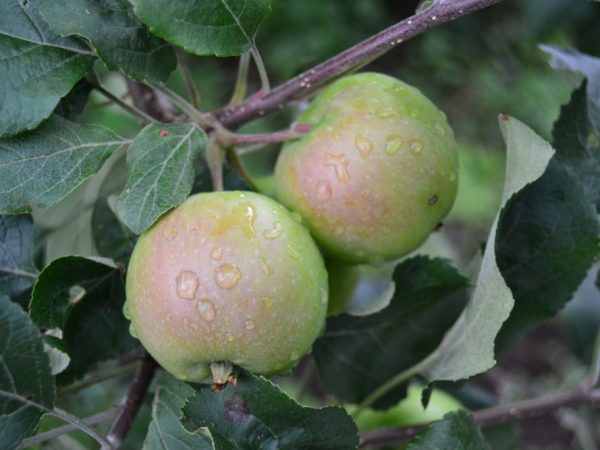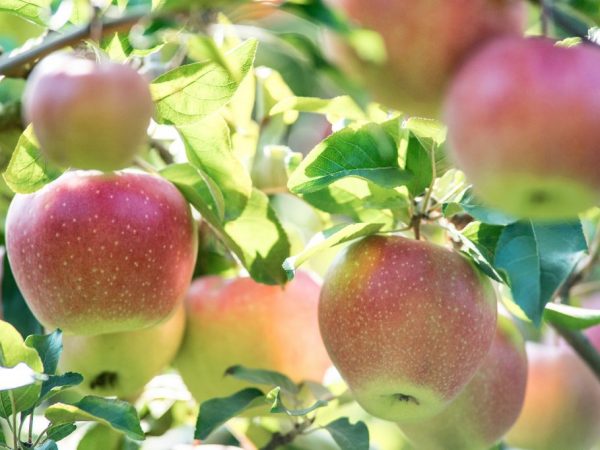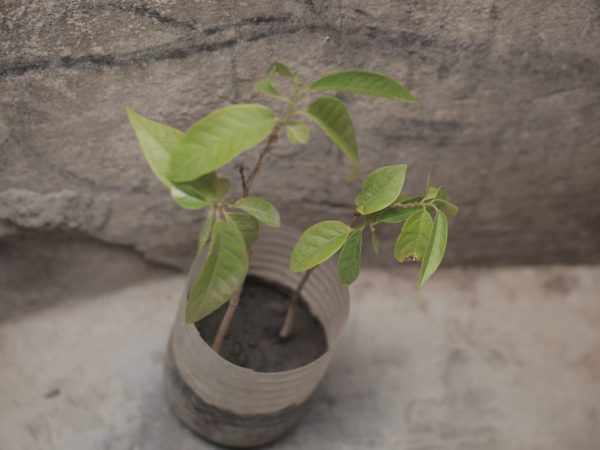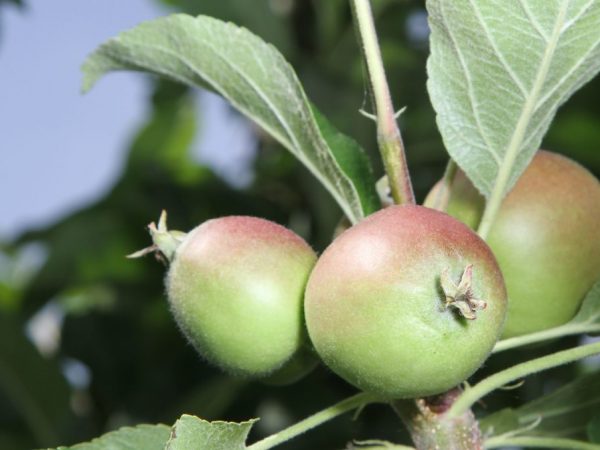Varietal features of the North Sinap apple tree
The North Sinap apple tree is considered a late winter variety. It is recommended by breeders due to the good keeping quality of fruits and early maturity. On the basis of the variety, Orlovsky Sinap, Moscow winter and Moscow later were bred. The apples are superior in taste to the southern varieties.
- Variety characteristic
- Advantages and disadvantages
- Description of the tree and fruit
- Taste
- Yield
- Self-fertility
- Winter hardiness
- Disease resistance
- Growing regions
- Features of the tree depending on the stock
- Landing
- Timing
- Technology
- Care
- Watering
- Top dressing
- Formation and pruning of the crown
- Protection against diseases and pests
- Features of ripening and fruiting
- Harvesting and storage
- Gardeners reviews

Varietal features of the North Sinap apple tree
Variety characteristic
These apple trees are recommended for use in breeding work when creating early varieties with good frost resistance. They are widespread throughout the country in summer cottages, gardens and industrial plantings.
Advantages and disadvantages
The variety is recommended for cultivation in cold climates. The tree can withstand temperature drops and frost well. Also, its advantages include:
- keeping quality of fruits;
- high taste;
- a bountiful harvest;
- unpretentious care;
- fruits do not deteriorate during transportation;
- high resistance to pests.
Like all varieties, North Sinup has its drawbacks. These include the large size of an apple tree on a full-grown scion and fruits of different sizes.
Description of the tree and fruit
Large apple tree, wide trunk. The height of the tree, which was grafted onto a vigorous stock, reaches 7 m in height and 6 m in width. Dwarf ones are more compact, they are slightly lower.
Leaves are green, medium size. Oval in shape, with a pointed end and a wide middle. Flowers are large, pink, unopened buds are red with a pleasant aroma.
Fruits weighing 100-140 g, round, when ripe become green with a red tint. Subcutaneous inclusions are subtle, but numerous.
Taste
The pulp is sweet and sour and crispy, with a delicate honey aroma, which attracts the attention of gardeners.
Its shade is pale white, fine grain is present. Tasters rate North Sinap apples quite high, at 5 points.
Yield

The yield of the tree depends on the quality of care.
The number of fruits is up to 160 kg from one adult apple tree. Brings harvest without interruption.
The fruits are large, differ in size and weight. The harvest begins to appear in 3-4 years. To increase the number of fruits, it is important to remove shoots and take care of the seedling every season.
Self-fertility
According to the description, this variety is self-fertile, but without pollination it can produce half as many apples. Pollinators are used to increase yields. For this variety, the following are well suited:
- Antonovka Ordinary;
- Slav;
- Pepin Saffron.
If there is not enough space on the site and there is nowhere to plant pollinating varieties, then a branch is grafted onto a tree that is already growing in the garden.
Winter hardiness
The North Sinap variety tolerates frost and cold.
The fruits do not lose their taste; they remain unchanged in appearance even at temperatures down to -35 ° C. Frost resistance species is only slightly inferior to the Antonovka Ordinary.
Disease resistance
The variety is resistant to diseases and harmful insects, but proper care must be followed to prevent disease and pest infestation.
Growing regions
The apple tree is frost-resistant, and it is customary to grow it in the northern regions of Russia. If it grows in the suburbs or in the Urals, there is no need to cover it. The North Sinap apple variety does not freeze at temperatures down to -20 ° C.
Only during periods when temperatures reached -40 ° C were minor damage to the trunk and branches observed. In Altai, freezing is more likely, you should choose an area protected from the winds and cover the tree in the first 3-4 years.
Features of the tree depending on the stock
The number of fruits and longevity of the culture depends on the stock on which the branches are grafted. They are divided into the following types:
- vigorous - the height of the apple tree is up to 8 m, it grows up to 70 years, the fruits begin to appear only at 7-8 years. Apples are not uniform in size and weigh up to 100 g;
- semi-dwarf - considered the best for beginner gardeners. It grows up to 4 m, fruits begin to appear in the second year after planting. They weigh up to 140 g, they have a pleasant and sweeter taste than those of strong-growing ones;
- dwarf is a small tree, it grows up to 3 m, fruits weighing 110-130 g. The life of an apple tree is 20-30 years.
Landing

It is advisable to plant in the autumn.
For the further development of culture, it is important to choose the right place for growing the tree. Basically, the planting of the North Sinap apple tree is carried out in the fall.
The tree does not tolerate strong winds. It is planted in open areas exposed to the sun.
Timing
Planting takes place in spring or autumn. It is correct to plant in autumn, from the beginning of September, so that the seedling has time to take root before frost.
Spring planting is carried out from early April to May. At this time, the variety is planted in the southern regions or if the seedling has reached the age of two.
Technology
It is important to choose the right landing sites. The distance between them should be at least 4 m. It is necessary to choose a site protected from gusty winds on a hill. Apple trees do not like areas with groundwater. Planting is divided into 5 stages:
- the root system is soaked in water for 10 hours;
- the pit should not be large - if the tree is 2-4 years old, a depth of 50-80 cm will be sufficient;
- a support up to 1.5 m high is placed on the bottom of the hole;
- it is important to spread the roots of the seedling;
- the pit is covered with earth, adding organic fertilizers;
- the tree is tied to a peg in two places.
Care
The culture does not require special care, but, like all apple trees, it needs high-quality feeding and watering.
If you do not cut the North Sinap apple tree, the fruits will become smaller and lose their taste. This variety has an average drought tolerance, it does not require a lot of water.
Watering
The procedure should be performed 3-4 times per season. Depending on the weather conditions and the place of planting, the apple tree is watered in different ways.
If the season is rainy, irrigation can be reduced by up to 2 times. The first time this is done after the appearance of the kidneys. If the weather is too hot, recharge every week until age 4.
The second time is watered after flowering and the beginning of fruit formation. The third time, this action is performed 2-4 weeks before harvest in order to nourish the tree and avoid freezing in winter.
The amount of water for each culture is calculated separately. For an apple tree that has reached one year, 25-35 liters of water per 1 sq. m. More mature trees need up to 7-9 buckets.
Top dressing

The apple tree needs fertilization during the fruit set
Fertilization is required during the growing season. The apple tree should be fertilized especially intensively during the growth of shoots and the formation of fruits.
For the formation of a good crown and proper growth of the root system of the seedling, it must be fertilized with chicken droppings or humus 2-3 times per season.
Formation and pruning of the crown
You need to prune the branches to form healthy and high-quality fruits. Tree crown pruning is carried out at the age of 2 to 8 years. There are different forms: sparse-tiered, cupped and vertical palmette.
If this is not done, the seedling begins to branch, and this will not allow you to get an even stem. When forming the crown, branches are removed that block the sun's rays, which should penetrate to the fruits.
Protection against diseases and pests
In spring, it is imperative to prune damaged and dry branches to control pests. Places of cuts should be treated with garden varnish. The wormwood solution will help protect the tree from the moth.
Fungal diseases and other ailments that harm the apple tree can be treated with a solution of the Strobi drug.
Features of ripening and fruiting
The tree quickly begins to bear fruit. Apples of the Northern Sinap variety begin to form on the branches as early as 4-5 years.
The harvest is of high quality and annual. An adult tree produces from 4 kg of apples per season. Dwarf seedlings begin to bear fruit in the 2nd year after planting. If you overdo it with feeding, there will be fewer apples and the tree will begin to grow foliage.
Harvesting and storage
If the fruits are harvested on time, their safety lasts until June at a temperature of 0-5 ° C. If it is higher than it should be, apples are stored until April.
The crop is put in a basement or other cold place. It should be stored in wooden crates or boxes in one layer.
Gardeners reviews
Gardeners who grow the North Sinap variety claim that the fruits are of high keeping quality and transportability. The winter variety can be stored for a long time, and the fruits can be consumed until summer without losing their benefits.
After the harvest, the apples are juicy and sweet; during storage, they ripen and "gain" useful elements. The taste becomes more pronounced and sweeter. If you choose seedlings on a dwarf rootstock, the crop can be harvested as early as the 2nd year after planting.

